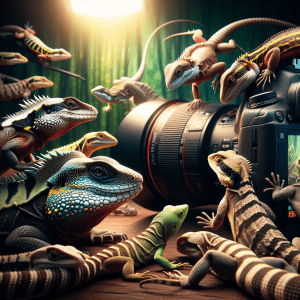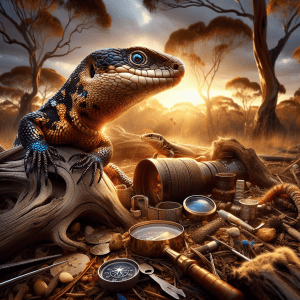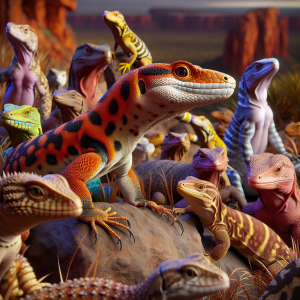Introduction to Lizard Reproductive Strategies in Australia
Imagine standing in the vast Australian outback, surrounded by unique wildlife and stunning landscapes. Now, picture observing a group of lizards engaging in their mysterious reproductive rituals. Fascinating, right? Today, we’re diving into the intriguing world of lizard reproductive strategies in Australia.
Let me share an interesting fact with you – did you know that some Australian lizard species exhibit complex mating behaviors that are specific to their environment and evolutionary history? It’s like watching a nature documentary unfold right before your eyes!
Now, let’s explore the diverse types of mating rituals these lizards perform. From elaborate courtship displays to fierce competition among males vying for females’ attention, each species has its own set of behaviors that contribute to the continuation of their lineage. Witnessing these rituals in the wild is like watching a captivating dance of nature’s creation.
As we delve deeper, we will uncover the intricate details of breeding seasons among Australian lizards. Imagine the desert coming alive with the sounds of mating calls and the sight of lizards preparing for the next generation. The timing of these breeding seasons is crucial for ensuring the survival of their offspring in the harsh Australian environment.
Now, think about this – what challenges do these lizards face during their reproduction journey? From predators lurking nearby to environmental changes affecting their nesting sites, these creatures navigate a myriad of obstacles to ensure the success of their reproductive strategies.
As we embark on this journey together, let’s unravel the mysteries of lizard reproductive strategies in Australia and gain a newfound appreciation for the remarkable adaptations these creatures have developed over time. Stay tuned for more insights into the captivating world of Australian lizard reproduction!
Types of Lizard Mating Rituals
Have you ever wondered about the wild and wacky world of lizard mating rituals in Australia? It’s truly a fascinating topic that sheds light on the intricate ways these reptiles go about finding their perfect partners. From flamboyant displays to intricate dances, Australian lizards sure know how to woo a mate.
Picture this – a male frilled lizard puffing up its colorful frill to impress a potential female partner. It’s like a lizard fashion show right in the heart of the Australian outback! These elaborate displays aren’t just for show; they play a crucial role in attracting a mate and establishing dominance in the lizard world.
But here’s an interesting fact for you: not all Australian lizards rely on flashy displays to find a mate. Some species engage in more subtle courtship behaviors, such as intricate head-bobbing movements or gentle nudges. It’s a diverse world out there, and each lizard species has its unique way of signaling readiness to mate.
Now, let’s dive deeper into the challenge of understanding these mating rituals. With such a wide variety of behaviors and signals, researchers face the daunting task of unraveling the mysteries of lizard courtship. How do scientists decipher the hidden language of lizard love? It’s a puzzle that keeps researchers on their toes, constantly seeking new insights into the fascinating world of reptile romance.
As we explore the captivating realm of lizard mating rituals in Australia, we not only gain a deeper appreciation for the natural world but also uncover valuable insights into the complexities of animal behavior. So next time you spot a lizard basking in the sun, take a moment to appreciate the intricate dance of life that unfolds right before your eyes.
Breeding Seasons of Australian Lizards
Breeding Seasons of Australian Lizards are truly fascinating! Did you know that these reptiles have specific times of the year when they are most active in terms of reproduction? It’s like they have their own calendar for creating the next generation of little lizards.
Imagine this – you’re strolling through the Australian outback, and suddenly you spot a pair of lizards engaging in a mesmerizing courtship dance. It’s their way of signaling that the breeding season has arrived. Australian lizards are quite punctual when it comes to these matters, ensuring they make the most of the optimal conditions for successful reproduction.
During the breeding season, male lizards often display vibrant colors and engage in territorial battles to win the attention of potential mates. It’s like a colorful and action-packed drama unfolding in the wild. Female lizards carefully assess the males’ displays before choosing their partners, ensuring the survival of their offspring.
Understanding the breeding seasons of Australian lizards is crucial for conservation efforts and wildlife management. By knowing when these reptiles are most active in terms of reproduction, researchers and conservationists can implement strategies to protect their habitats and ensure the sustainability of their populations.
So, the next time you spot a lizard basking in the sun or scurrying across the desert sands, take a moment to appreciate the intricate timing and behaviors that contribute to the continuation of life in the fascinating world of Australian lizards. The breeding seasons of these reptiles offer a glimpse into the wonders of nature and the delicate balance that sustains ecosystems across the continent.
Egg-laying Behaviors of Native Lizard Species
Have you ever thought about how lizards in Australia lay their eggs? It’s quite fascinating! Australian lizards have developed unique egg-laying behaviors that play a crucial role in their reproductive strategies.
When it comes to egg-laying behaviors of native lizard species, there are some intriguing facts to consider. For instance, did you know that some Australian lizards exhibit site fidelity when choosing their nesting locations? This means that they return to the same spot year after year to lay their eggs. It’s like having a favorite cozy corner in your house where you feel comfortable and safe.
Another interesting aspect is the variation in egg sizes and shapes among different species of Australian lizards. Some lizards lay small, elongated eggs, while others produce larger, rounder eggs. These variations are influenced by factors such as the lizard’s size, habitat, and reproductive strategy.
Now, imagine encountering a lizard in the wild diligently digging a hole in the ground to create a nest for its eggs. It’s a sight to behold and a reminder of the intricate behaviors that have evolved over time to ensure the survival of these remarkable creatures.
Considering the practical side of things, if you ever come across lizard eggs in the wild, it’s essential to observe from a distance and avoid disturbing the nesting site. By respecting their natural behaviors, we can help protect these delicate processes and contribute to the conservation of Australian lizard species.
Reflecting on the broader implications, the egg-laying behaviors of Australian lizards highlight the intricate balance between reproduction and environmental factors. Studying these behaviors not only provides insights into the natural world but also underscores the importance of preserving diverse ecosystems for the survival of these unique reptiles.
Next time you spot a lizard scurrying across the Australian landscape, take a moment to appreciate the remarkable journey it has embarked upon, from mating rituals to egg-laying behaviors, in its quest to ensure the continuation of its species.
Incubation Periods and Nesting Habits
Have you ever wondered about the intricate process of lizard reproduction, especially in the unique context of Australian species? It’s truly fascinating to delve into the egg-laying behaviors and nesting habits of these remarkable creatures.
Australian lizards exhibit a diverse range of egg-laying behaviors, each tailored to their specific environment and survival needs. From the meticulous selection of nesting sites to the careful arrangement of eggs, these reptiles showcase remarkable instinctual behaviors that ensure the survival of their offspring.
One interesting fact about Australian lizards is that the incubation periods for their eggs can vary significantly depending on the species and environmental conditions. Some lizards may lay eggs in burrows underground, where the constant temperature helps in the development of the embryos, while others may opt for exposed locations to benefit from external heat sources.
Understanding the incubation periods and nesting habits of Australian lizards not only provides insights into their reproductive strategies but also sheds light on the challenges they face in their natural habitats. Factors such as predation, climate change, and habitat destruction can impact the success of egg incubation and the survival of hatchlings.
Consider the broader implications of these reproductive behaviors. How do environmental changes affect the nesting habits of Australian lizards? What can we learn from their adaptations to ensure their conservation and protection in the face of ongoing environmental challenges? By exploring these questions, we can appreciate the intricate balance between reproduction and survival in the world of Australian lizards.
Environmental Factors Influencing Reproduction
Have you ever thought about how environmental factors play a crucial role in shaping the reproductive strategies of Australian lizards? It’s truly fascinating to see how these amazing creatures adapt to their surroundings to ensure successful reproduction.
When it comes to lizard reproduction in Australia, the impact of environmental factors cannot be underestimated. From temperature and humidity levels to food availability and habitat conditions, these variables influence every aspect of a lizard’s reproductive cycle. For instance, did you know that some lizard species adjust their breeding seasons based on environmental cues such as rainfall patterns and temperature fluctuations? It’s like they have their own built-in calendar that guides their reproductive behaviors.
Imagine encountering a female lizard carefully selecting the perfect nesting site, taking into account factors like sunlight exposure and soil composition to create an ideal environment for her eggs. This attention to detail highlights the intricate balance between environmental conditions and reproductive success in the world of Australian lizards.
Considering the broader implications of how environmental factors impact lizard reproduction raises important questions about conservation efforts. With climate change and habitat destruction posing significant threats to wildlife, understanding how lizards adapt to changing environments becomes crucial for their survival. How can we protect these unique reproductive strategies to ensure the long-term viability of Australian lizard populations?
Exploring the intricate relationship between environmental factors and lizard reproductive strategies not only sheds light on the fascinating world of these reptiles but also underscores the importance of preserving their natural habitats. Next time you observe a lizard basking in the sun or digging a nest in the ground, take a moment to appreciate the intricate dance between nature and reproduction that shapes their lives.
Adaptations for Reproduction in Australian Lizards
Have you ever thought about how Australian lizards have adapted their reproductive strategies to thrive in their unique environment? It’s truly fascinating to see how these creatures have evolved to ensure the survival of their species. Let’s dive into the world of lizard reproduction in Australia and explore the incredible adaptations they have developed over time.
One interesting aspect to consider is how environmental factors play a crucial role in shaping the reproductive behaviors of Australian lizards. From temperature and humidity levels to the availability of food and shelter, these factors influence every aspect of their reproductive cycle. It’s like a carefully choreographed dance where each move is essential for their survival.
Imagine witnessing a female lizard carefully selecting the perfect nesting site, taking into account the temperature and moisture levels to provide the ideal conditions for her eggs to develop. It’s a testament to the intricate balance of nature and the instinctual knowledge these creatures possess.
As we ponder the adaptations for reproduction in Australian lizards, we can’t help but marvel at their resilience and ingenuity. From camouflage techniques to escape predators to specialized mating calls and displays, these lizards have honed their skills over generations to ensure successful reproduction.
Exploring the world of lizard reproductive strategies in Australia not only provides us with a glimpse into the fascinating lives of these creatures but also raises questions about the broader implications of their survival. How can we, as stewards of the environment, help protect these unique species and their habitats? It’s a call to action that reminds us of the interconnectedness of all living beings on our planet.
So, next time you spot a lizard basking in the sun or darting across the bush, take a moment to appreciate the incredible adaptations that have allowed them to thrive in the diverse landscapes of Australia. Their reproductive strategies are a testament to the wonders of nature and the endless possibilities of evolution.
Comparison with Lizard Reproduction in Other Regions
Imagine this – Australian lizards performing their unique mating dances under the scorching sun, a sight to behold! These reptiles have some fascinating reproductive strategies that set them apart from their counterparts around the world.
Let’s dive into the comparison between lizard reproductive strategies in Australia and other regions. It’s like comparing the diverse flavors of ice cream – each with its own twist but equally delightful. Take, for instance, the viviparous skinks in Australia that give birth to live young, a rarity in the lizard world. Meanwhile, in other regions, egg-laying remains the dominant mode of reproduction among various lizard species.
Picture this: a male frilled lizard in Australia flaunting its impressive frill to attract a mate, while a chameleon in a different part of the world changes colors to signal mating readiness. These contrasting behaviors showcase the incredible adaptability of lizards to their environments.
Now, here’s an interesting tidbit – did you know that some Australian lizards engage in communal nesting, where multiple females share a nesting site? It’s like a lizard version of a shared housing arrangement, promoting a sense of community among these reptiles.
As we explore the differences in lizard reproductive strategies globally, it raises thought-provoking questions about the evolutionary forces that have shaped these behaviors. How have environmental factors influenced the development of these diverse reproductive strategies? What can we learn from these adaptations that may inform conservation efforts for lizard populations worldwide?
By delving into the nuances of lizard reproduction across regions, we gain a deeper appreciation for the intricacies of nature’s design. So, next time you spot a lizard basking in the sun, remember the remarkable diversity of reproductive strategies that make these creatures truly fascinating.
Conservation Implications of Lizard Reproductive Strategies
Conservation Implications of Lizard Reproductive Strategies are crucial when we consider the broader impact of human activities on the delicate balance of ecosystems. Picture this – you’re walking through the Australian Outback, the sun beating down on the red earth around you. You spot a lizard darting across your path, its sleek scales glistening in the sunlight. It’s a magical moment, a glimpse into the unique wildlife that calls this rugged landscape home.
Now, imagine if these lizards were suddenly faced with threats that disrupted their reproductive strategies. Climate change, habitat destruction, pollution – these are just a few of the challenges that can have a significant impact on lizard populations. As we delve deeper into the conservation implications of lizard reproduction, we uncover a pressing need to protect these fascinating creatures and the environments they inhabit.
The survival of lizard species is intricately linked to their ability to reproduce successfully. By understanding their reproductive strategies and the factors that influence them, we can develop targeted conservation efforts to safeguard these species for future generations. It’s not just about preserving a single species; it’s about maintaining the intricate web of life that sustains our planet.
So, what can we do to ensure the conservation of lizard reproductive strategies in Australia and beyond? It starts with raising awareness about the importance of these creatures in their ecosystems. Educating ourselves and others about the threats they face and the critical role they play is a crucial first step. Additionally, supporting conservation initiatives, advocating for habitat protection, and promoting sustainable practices are essential actions we can take to make a positive impact.
By taking proactive measures to conserve lizard reproductive strategies, we are not only safeguarding the future of these fascinating creatures but also contributing to the preservation of biodiversity and the health of our planet as a whole. The choices we make today will shape the world we pass on to future generations, so let’s strive to be stewards of the natural world and protect the incredible diversity of life that surrounds us.
Conclusion and Future Research Directions
When it comes to the conservation implications of lizard reproductive strategies in Australia, it’s truly fascinating to consider how our actions can impact these unique creatures. Imagine this – you’re out hiking in the Australian outback, and you come across a group of lizards engaging in their elaborate mating rituals. It’s a sight to behold, a reminder of the intricate ways these creatures ensure the survival of their species.
An interesting fact to ponder is that many Australian lizard species are already facing challenges due to habitat loss and climate change. The timing of breeding seasons and availability of resources are crucial for successful reproduction, and any disruptions to these factors can have significant repercussions on lizard populations.
As we observe these amazing creatures in their natural habitat, it’s important to reflect on our role in their conservation. Are we doing enough to protect their habitats and ensure their continued survival? How can we strike a balance between human activities and the needs of these unique reptiles?
Considering the broader implications, the conservation of lizard reproductive strategies goes beyond just preserving a single species. Lizards play a vital role in the ecosystem, serving as both predators and prey. By safeguarding their reproductive habitats and ensuring their populations remain healthy, we are contributing to the overall biodiversity and stability of the environment.
So, next time you come across a lizard basking in the sun or scurrying across the rocks, take a moment to appreciate the intricate nature of their reproductive strategies and consider what you can do to support their conservation. After all, these fascinating creatures are an integral part of Australia’s rich and diverse ecosystem.




